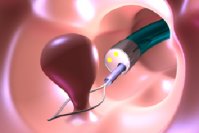During a colonoscopy procedure we look for any abnormalities such as redness, irritation or polyps. Most times polyps are removed at the time of examination. The advantage of colonoscopy over barium enema, virtual colonoscopy and other methods of viewing the colon is that the colon is both examined and biopsies taken or polyps removed.
Typically a colonoscopy takes between 10 and 15 minutes. Most patients choose a light sedation for the examination so that they are sleepy but there are some patients who prefer no sedation. The advantage of sedation is that one is comfortable and anxiety is reduced. If sedation is given, that patient is instructed not to drive for 24 hours and to go home and rest for the remainder of the day. If no sedation is given the individual can go back to work or to his/her normal activities immediately. Usually, people feel somewhat bloated after a colonoscopy but this passes very quickly and the after effects should be very minimal.
Most people say that the colonoscopy itself is less uncomfortable than the preparation. There are several different preparations on the market but at Woodbine Endoscopy, we believe that Pico-Salax is a very effective laxative that is easy to take. It is absolutely critical that the entire preparation directions are followed as a clean colon is necessary to completely examine the wall of the bowel. We always make a point of stressing how important the preparation is because we find that the most common problem is inadequate preparation. Occasionally, we have to reschedule the examination entirely when directions have not been followed. We encourage all patients to review the instructions as soon as they receive them and then again several days before the examination because of dietary restrictions.
On the morning of the procedure, the patient comes to our clinic accompanied by a family member or a friend who is there to accompany them home. The patient is registered at our reception area and then in a private examination room, a registered nurse completes a preliminary assessment. The physician performing the examination will take the patient’s medical history. The colonoscopy procedure itself takes about 10-15 minutes and then the patient is accompanied to a comfortable recovery room. The time spent in the recovery room is typically one-half to one hour. We ask all our patients to plan their day accordingly. 
Many patients ask how we remove polyps. We remove polyps at the time of examination and it is not necessary to insert a separate instrument to do so. We put a looped wire around the polyp, apply electrical current and then cauterize (or burn off) the polyp. The physician then grabs the polyp with the instrument and the polyp is then sent off to the laboratory for examination. Interestingly, the colon has no nerve cells in the inner walls and there is no discomfort whatsoever. Because we use electrical current to cauterize the polyp, there should be no bleeding.
We believe and hope that by utilizing the colonoscopy procedure on a periodic basis, we have a window of opportunity. We can remove precancerous growths when they are small instead of surgical intervention. While we certainly cannot stop all cancers from developing, we think that by having regular screening colonoscopies a patient can minimize the incidence of colon cancer.
 Procedure Instructions.
Procedure Instructions.

